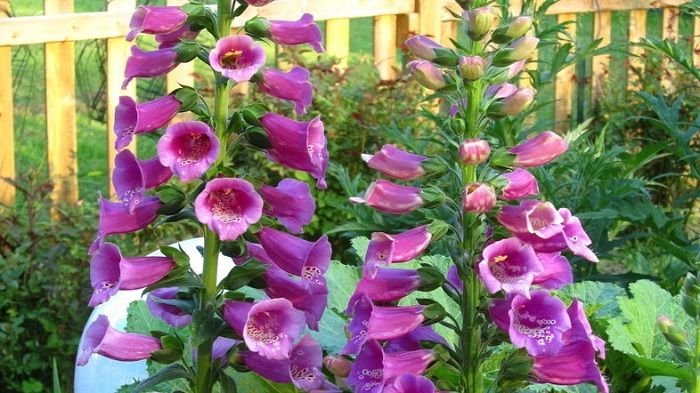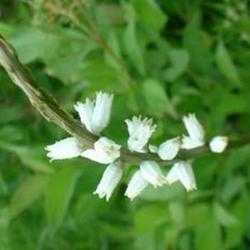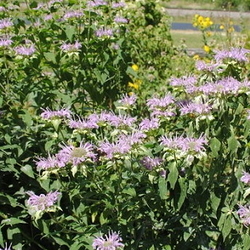Sometimes I could get away with not wearing my asphidity bag when I went in search of plant treasures with my great Aunt Bett. If the plant we were searching for happened to be in her garden, she must have thought no harm would come to me there, so I didn't have the stinking thing draped around my neck. But there was one plant that she insisted was worth two asphidity bags, and I could never talk my way out of that one. Not only were two asphidity bags hanging from cords around my neck, but I also had to wear somebody's very big gardening gloves to cover my hands. I thought the mysterious plant must surely be magical.
If that were true, then what were we doing in my mother's back yard? There we were, me in my overalls, long sleeved shirt, bonnet on my head, two asphidity bags around my neck and huge gloves covering my hands, and there was Aunt Bett wearing gloves, too. She said it was time I learned a few things. Well, I thought that was what I had been doing on all those trips up and down the mountain.
She started her lesson as we sat on the edge of the back porch facing my mother's medicine garden. Medicine gardens in those days consisted of old medicinal plants that were most likely used with regularity as remedies for sore throats, earaches, and the common cold. My great Aunt Bett thought everybody should have a medicine garden. First she pointed out bee balm and she said: "Bee balm's for makin' a tea that helps git rid of sore throats an' colds. It also helps for sleepin' at night. Bee balm ain't gonna hurt you none. And then there's spiderwort. It makes a poultice for puttin' on bug bites an' stings. It don't hurt you none, neither. There's comfrey, that one will help if you cut yourself, cause it's a binder plant. An' the daylilies, well I reckon you already know that it gits rid of high fever, and I reckon it takes care of jaundice, too. They're the ones we don't have to worry 'bout. They're the good plants. But the foxgloves, now they're right dangerous."
I must have looked at her with fear on my face because this was the first time she had ever set me down and taught me a lesson. Normally I was afraid of only a few things: bears, haints, the debbil, and a boy named Joe Devlin, but I had never been afraid of a plant until that very minute. She gave me a very serious look and then she explained: "Foxglove has in its leaves a potent heart medicine, an' it's poison to a body that takes it when they don't need it." I was appropriately frightened, but I did manage one question: "Aunt Bett, how do you know if a body needs it?"
Aunt Bett went on to tell me that when she saw folks with excessive fluid retention, around their ankles and their hands, she knew the problem was related to heart failure. Digitalis, taken from the leaves of the foxglove, was one of the most useful drugs in treating this condition, and to this day it still is. [1]

Foxglove, Digitalis purpurea, is grown in gardens as a popular flower and also grows wild along roadsides and in meadows throughout most of the United States. It was brought to the U.S. by European migrants centuries ago. It has tube-shaped, spotted purple flowers in various shades including pink. The plants grow to about 5 feet tall, with many large thick hairy leaves at the base of the tall stem. Of course, the garden variety will vary in height as well as color.
It was such a beautiful plant, I remember helping Aunt Bett collect the leaves, but I was never allowed to help her make a decoction from them. She was that careful when handling the plant. The only time I got in trouble with foxglove, well, it was like this: Aunt Bett talked about the poison in the leaves, but she said nothing about poison in the flowers. So after we got through gathering the leaves from the foxgloves there in Mom's back yard medicine garden, I took off my gloves and began to stick my fingers up into the long cup-shaped flowers. They broke off on my fingers and I was delighted with my flowery fingernails. I ran in the kitchen to show everybody. The punishment was not as bad as it could have been. I was hand delivered into the bathroom and plunked down in the tub. My mother jerked those clothes off me like I had been wallowing around in a pig pen. She turned the water on, with me yelling my lungs out, "I din't eat no leaves, Momma, I din't put a thang from that foxglove in my mouth. I promise, I was just tryin' on fingernails."
I guess my mother was too upset to say a word, or maybe if she did, I couldn't hear her over my own yells.
It is a dangerous plant and not to be taken lightly. In the late 1700s a doctor named William Withering began studying foxglove. He learned that an effective medicine for treating heart ailments could be made from drying its leaves. He also learned that this medicine, digitalis, could be poisonous if the patient were given too much. Withering was aware that digitalis was only effective in certain forms of edema, but apparently did not associate this with the cardiac actions of the drug. By the 1800s two French scientists found the substance digitalin in the plant, and by the late 1800s the potent chemical digitoxin was discovered. In 1930 the English chemist Sydney Smith obtained the medicine used today, digioxin, from the wooly foxgove plant, Digitalis lanata. [2]
There are other drugs used today that come from plants, those same plants that our ancestors used in spite of with their limited knowledge. There is a surgical anesthetic that is derived from the curare vine; an active ingredient in decongestants, ephedrine, is found in the stem of a Chinese shrub. Aspirin is a painkiller derived from the willow tree bark; there are plants whose chemicals are used for hypertension, antispasmodic medicines, glaucoma treatments, and antidote remedies. A lot of the old herbal remedies have stood the test of time. [1]
I find it interesting that those who lived long ago when doctors were scarce, and when reliance upon nature for all needs was the standard, so many of their same plants are those that are used for the same ailment today. How did they know that, those ancestors of ours? I still like to make soaps and dyes using herbs, but I am glad I can leave medicines to those who are far more knowledgeable than I.
The more I research, the more I realize the depth of knowledge that was handed down to us from our ancestors. I am very fortunate to have had an Aunt Bett to fill my life with a deep appreciation for nature. Sometimes I think if I were given just one more day with her, it would be worth digging up those old asphidity bags that I buried so long ago!
[1] Dr. S. Urbach, University of Louisville School of Medicine
[2] http://www.discoveriesinmedicine.com/com-En/digitalis.html
All other information is in my family writings.
For more information on asphidity bags go here: http://davesgarden.com/guides/articles/view/780/
All photos are from Plant Files

















